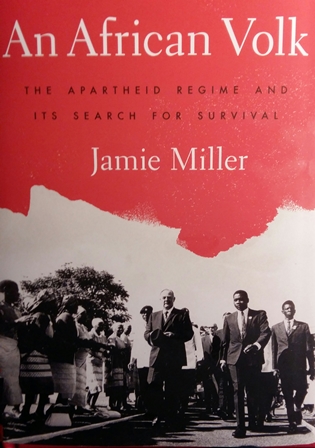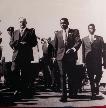Review of Jamie Miller’s, An African Volk- The Apartheid Regime and its Search for Survival, Oxford University Press, New York, 2016, 439 pages, price N$ 725,00.
This is an extraordinary book. It details the policies pursued by John Vorster during his tenure as Prime Minister (1966-1979). Events inside SA are presented with sound observation and documented authoritatively. The global and regional repercussions of some of the ill-fated decisions are dissected and laid bare. He cuts to the bone in exposing Afrikanerdom's troubled efforts to make itself compatible with the post-colonial world.
What went into the final product demonstrates tenacity and perseverance. The author, an Australian, came to South Africa to fathom what John Vorster was all about. For any South African that would have been a daunting task. For a foreigner even more so to work his way through stacks of archival material and official cabinet documentation, including the minutes of their meetings.
For five arduous years he spent his days delving for what was hidden between those pages. He spared no effort to travel throughout Southern Africa to pick the brains of nearly all the personalities who were still around from the Vorster days. He mastered Afrikaans so that he could read and understand that language. He interpreted the Afrikaans nuances almost to perfection. All of that enabled him to present the many facets of the man so many admired and even more that despised him.
Vorster’s engagement with the outside world was overshadowed first of all by the Rhodesian problem for which the likes of Kissinger and others accepted him as key in unlocking the intransigence of Ian Smith. Slowly South West Africa (SWA, but now Namibia) gained similar prominence on the agendas with Vorster.
It is this latter issue which brought new insights into what happened during the turbulent years after the demise of the Portuguese prominence in Angola in late April 1974. Consequently, and mainly due to limited space, Rhodesia will be skipped and attention will be focused on what new insights have come from the parts of the book fleshing out issues surrounding Namibia.
In that regard four main trends have been identified that caused Miller to search more and deeper for what could make sense for that what occurred: firstly, South Africa’s military move into Angola at an early stage and its subsequent ignominious withdrawal; secondly, political developments inside Namibia; thirdly, searching for an international solution of the Namibian question via the Western Contact Group and the first steps towards Resolution 435; and fourthly, what led to the Cassinga raid.
At the end the reader will agree that Miller does not suffer from, what Henry Kissinger once termed, “deficiency of history”. Miller understands the history of the time and places it in a perspective which makes sense and enables the reader to realise what really went on during those years; why it went wrong; and most importantly, the fallout from all that went wrong.
Four segments from the book are of special relevance to Namibia. They are dealt with below and substantiated with copius quotes from the book.
 The military move into Angola and the subsequent retreat back into then SWA have intrigued many observers for years. Then Minister of Defence, P.W. Botha, relied on what his sources in Washington led him and his back door interlocutors to believe to be credible information. Botha and his merry men were soft soaped in classical style. What they did not understand, let alone appreciate, was the American mood after Vietnam and how that manifested itself in future action by Congress. Oblivious to that sea change in the USA Botha allowed his forces to penetrate ever deeper into Angola.
The military move into Angola and the subsequent retreat back into then SWA have intrigued many observers for years. Then Minister of Defence, P.W. Botha, relied on what his sources in Washington led him and his back door interlocutors to believe to be credible information. Botha and his merry men were soft soaped in classical style. What they did not understand, let alone appreciate, was the American mood after Vietnam and how that manifested itself in future action by Congress. Oblivious to that sea change in the USA Botha allowed his forces to penetrate ever deeper into Angola.
Miller devotes substantial space backed by numerous sources to expose “Pretoria’s deception over Angola” and coming to the conclusion that the “Angolan adventure was an unmitigated disaster”. But the ramifications were more severe. Miller describes how hostility to apartheid was central to the disastrous emphasis on secrecy and deception and ending up in shaping “a potent alignment of communist block power and African radicalism on the ground in Southern Africa … and one explicitly aimed at the overthrow” of the SA government.
One aspect few observers have ever touched upon is Miller’s exposé of how the intervention in Angola “had substantially alienated Africans at home”. What becomes fascinating is when he explores the answer to his own question: “how was Botha able to avoid bearing responsibility for the Angolan disaster entirely”. He slaughters many holy cows in explaining how Botha escaped “any repercussions for his headlong pursuit of the disastrous intervention in Angola”. But most important he identifies the reasons why Botha “emerged stronger than ever”.
Miller highlights with supporting arguments the consequential fall out from Botha and his military establishment having “secured increased leeway to execute their more assertive national security strategies” and thereafter has had to pay an even greater price in terms of human lives, financial commitments and international isolation and condemnation.
In between Miller does not neglect to pay due attention to what was happening on the ground inside SWA. Vorster realized that SWA required his attention. He obliged and gave it his full. In that process he identified the “need to produce a viable, anticommunist state that would allow South Africa to divest itself of a commitment that was proving more trouble than it was worth”. But the vehicle for which he himself laid the ground work and witnessed its formation, the Turnhalle Alliance, proved incapable of delivering that what Vorster so desperately wanted to achieve. The exclusion of SWAPO was that great miscalculation.
The more it was excluded the more the solution became intractable. Then in September 1976, Vorster having agreed to Kissinger’s Seven Point structure for a transition to independence by the end of 1978, implored Kissinger to add this to that mix: SWAPO must first give “an undertaking to renounce violence and cease all insurgent activity”. Miller relates how “SWA’s whites [read National Party] were not fulfilling the role envisaged for them by Kissinger and Vorster”. But equally significant for Miller was that “the feasibility of the Seven Point Points was also being undermined by SWAPO”. Consequently, the process that Kissinger and Vorster sponsored collapsed entirely in early 1977.
Not only for those two reasons but the incoming Carter administration disavowed that whole exercise early in 1977. That in turn created the opportunity for that new administration, together with its four fellow members on the Security Council at that time, to start crafting the Western (Contact Group) Five’s Proposals. [What is absolutely beyond belief is that Botha as President nearly 10 years later insisted that Nelson Mandela and the ANC must also first renounce violence. Obviously he did not learn anything from his predecessor’s miscalculation on that score! Perhaps he was just plain stubborn.] Under the guidance of Vorster South Africa accepted the Western Five’s Proposals in April 1978. The euphoria about that acceptance was however short lived.
While going along with the cabinet’s decision to accept the Western Group’s Plan Botha had his own agenda worked out. Over several pages Miller relates how Botha extracted a quid pro quo from Vorster and his fellow cabinet colleagues for his support for what Pik Botha wanted and was granted by cabinet. Within weeks Cassinga followed.
For Botha Cassinga might have brought military satisfaction and further helped to ensconce his own political power base, but he never calculated the irreparable harm it caused SA in SWA and internationally. For him it was all about strong arm politics. He believed in and pursued “combative solutions”. The “potential of diplomacy” was for him a foreign concept which he abhorred and seldom practised. The only useful purpose diplomacy could serve was to buy time. And in the end he could not show what he had done with all the time his diplomats secured for him.
In pursuing his combative solutions he ended up with a bankrupt ideology – the total onslaught. Its first victim was Cassinga. Miller aptly captures this as follows: “Cassinga had entrenched the validity both of total onslaught as a system of threat perception and of total strategy as an effective paradigm for national security”. Miller defines this precisely: “Cassinga thus introduced the model of confrontation between the regime and the world that would dominate the next decade. Cassinga brought excruciating pain to all Namibians and has left indelible scars on the national psyche that are traumatically recalled every year on Cassinga Day, a national day of remembrance on 4 May. On that day in 1979 Namibians languished in the trenches at Cassinga.
From that day onward SA’s reputation internationally sank to an ever lower level. The credibility gained by accepting the Five’s Proposals evaporated overnight. For years to come SA was seen and treated as an unreliable partner in the search for Namibia’s independence. What Cassinga caused SA in lost credibility has never been determined in full.
Riaan Eksteen served for 27 years in the SA Foreign Service - of that he devoted 16 years to the issue of Namibia. He held four ambassadorial posts - UN New York and Geneva, Turkey and being SA’s first Ambassador to Namibia. Since 2000 he has been a permanent resident of Namibia and lives in Swakopmund.

